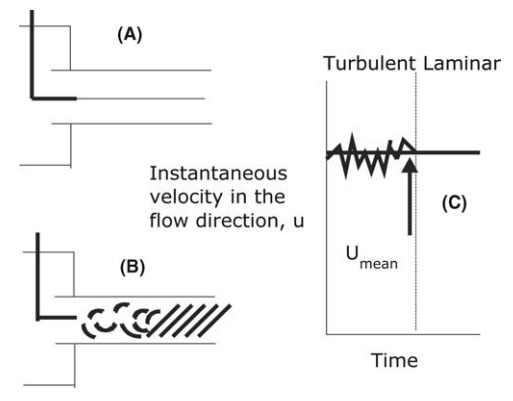Laminar and Turbulent Flows
| Home | | Pharmaceutical Technology |Chapter: Pharmaceutical Engineering: Fluid Flow
The translation of the energy of flow from one form to another has been described with little reference to the actual nature of flow.
LAMINAR AND TURBULENT FLOWS
The
translation of the energy of flow from one form to another has been described
with little reference to the actual nature of flow. Flow of fluids can be
laminar (and may be depicted by streamlines) or turbulent, terms that are best
introduced by describing a series of simple experiments performed in 1883 by
Osborne Reynolds. The apparatus, shown in Figure 2.8, consisted of a straight
glass tube through which the fluid was allowed to flow. The nature of flow may
be examined by introducing a dye into the axis of the tube. At low speeds, the
dye forms a coherent thread, which grows very little in thickness with distance

FIGURE 2.8 The Reynold’s experiment (A) Laminar; (B) Turbulent and; (C)
illustration of the use of a mean velocity for turbulent flow.
However, with progressive increase in speed, the line of dye first
began to waver and then break up. Secondary motions, crossing and recrossing
the general flow direction, occur. Finally, at very high speeds, no filament of
dye could be detected and mixing to a dilute color was almost instantaneous. In
this experiment, flow changes from laminar to turbulent, the change occurring
at a critical speed. Generalizing, in laminar flow, the instantaneous velocity
at a point is always the same as the mean velocity in both magnitude and
direction. In turbulent flow, order is lost and irregular motions are imposed
on the main steady motion of the fluid. At any instant of time, the fluid
velocity at a point varies both in magnitude and direction, having components
perpendicular as well as parallel to the direction of net flow. Over a period
of time, these fluc-tuations even out to give the net velocity in the direction
of flow.
In
turbulent flow, rapidly fluctuating velocities produce high-velocity gradients
within the fluid. Proportionately large shear stresses are developed, and to
overcome them, mechanical energy is degraded and dissipated in the form of
heat. The degradation of energy in laminar flow is much smaller.
The
random motions of turbulent flow provide a mechanism of momen-tum transfer not
present in laminar flow. If a variation in velocity occurs across a fluid
stream, as in a pipe, a quantity of fast-moving fluid can move across the flow
direction to a slower-moving region, increasing the momentum of the latter. A
corresponding movement must take place in the reverse direction elsewhere, and
a complementary set of rotational movements, called an eddy, is imposed on the
main flow. This is a powerful mechanism for equalizing momentum. By the same
mechanism, any variation in the concentration of a component is quickly
eliminated. Admitting dye to the fluid stream in Reynolds’ original experiment
showed this. Similarly, the gross mixing of turbulent flow quickly erases
variations in temperature.
The turbulent
mechanism that carries motion, heat, or matter from one part of the fluid to
another is absent in laminar flow. The agency of momentum transfer is the shear
stress arising from the variations in velocity, that is, the viscosity.
Similarly, heat and matter can only be transferred across streamlines on a
molecular scale, heat by conduction and matter by diffusion. These mechanisms,
which are present but less important in turbulent flow, are com-paratively
slow. Velocity, temperature, and concentration gradients are, there-fore, much
higher than that in turbulent flow.
Related Topics
